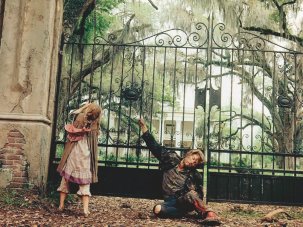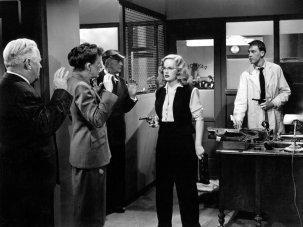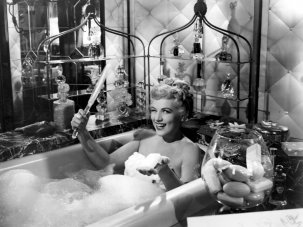“He tried, and succeeded, in looking on her obvious unhappiness as something morbid and female, altogether outside his control.”
— Reflections in a Golden Eye (Carson McCullers)
In Bed Outdoors (c. 1935)
from the Moving Image Research Collections of the University of South Carolina University Libraries
If this is Major Langdon’s expedient perception of the suffering of his young wife Alison, who – like the supine star of this month’s archive clip – is often to be found propped up in bed, wearing a white nightgown, it is nothing to the notions of their neighbour Captain Penderton who “loathed her so much that he could scarcely bear to look at her”. Alison takes a different view of her husband’s feelings toward her indisposition, resignedly confident that the Major “thought it all a hypochondriacal fake that she used in order to shirk her duties – that is, the routine of sports and parties which he thought suitable.”
Thus the Georgia-born McCullers – herself bedridden for long periods of her life – gives a 360-degree view of the invalid Alison. By extension, her novel – and to a lesser degree, John Huston’s 1967 film adaptation – imparts a fuller picture of the fragile figure of woman that abounds in Southern Gothic tradition – in fiction and on film.
One such woman takes centre stage in the above home video, shot in 1935 and belonging to the Moving Image Research Collections of the libraries of the University of South Carolina. Fulfilling the Southern Gothic brief in more ways than one, it shows a convalescent whose bed, and she tucked in it, have been transposed out of doors. Whatever occasioned the stunt – for fun and/or fresh-air – the film’s ensemble hadn’t planned for the weather: a rude wind that lifts the linen and brings well-doers scuttling to straighten the ‘set’. The woman both is and playacts the starring-role of patient, spiritedly thrusting out her tongue at a man who measures her pulse. Her head rolls on the pillow as she laughs; she takes pleasure in this theatre, in self-pastiche.
But the queerness of this dumb show isn’t all that’s suggestive of the Southern Gothic genre. The clip boasts, too, the short, sharp stabbings of macabre – see the revenant in broad-brimmed hat setting down a vase on the nightstand. And whose idea that the scene be steeped in radioactive orange, which – belying the breeze – makes the tableau appear airless as a bell jar; this woman trapped as an insect in amber? A distant smoking chimney deceives as it aligns with the parting of her hair, showing us instead a febrile woman coming to the boil like a stovetop kettle: a wisp of steam escaping her head, letting pressure off the brain. If the film weren’t silent, would she whistle? Will she watch it back on returning to her room: her reflection in an ersatz eye?
The stirring of the ostrich-feather bedspread brings to mind another vulnerable Southerner: the murdered Willa Harper in Charles Laughton’s The Night of the Hunter (1955) – a film this footage preceded by exactly 20 years. The fanned plumage looks not unlike the weeds and Willa’s hair wafting softly in the current, her cadaver seated in a stolen car at the bottom of the Ohio river: another bed, Willa’s deathbed, not where it ought to be.
Withdrawal or taking to bed brings a particular stigma in the South: not so much for the working-class Willa as the patrician white woman with a plantation-past. She vies with a bygone paragon of Southern hospitality, of charm, brio, and the kind of grace that sweeps into a room in hooped skirts. (Cleaving to this ideal, with her Old South manners and “worn-out Mardi Gras outfit”, makes Blanche DuBois incongruous to the New Orleans setting of Elia Kazan’s A Streetcar Named Desire (1951), adapted for screen by its author Tennessee Williams.) This readiness for public reception is what matters most of all: the debutante descending the staircase to all-eyes and approval. Within this social framework, the white sheets of bed-rest are shroud; a flag of surrender that says I can’t do it. A need of care, instead of its provision, makes a woman good-for-nothing.
Little Edie of the Maysles’ Grey Gardens (1975) knows this very well. It is the bass note of her constant complaint, of her bickering with her mother. Little Edie wants out of that house. She is wasted in its decrepitude, and “If you can’t get a man to propose to you, you might as well be dead.” What’s the use unless you’re looked at? – visible as she was when walking a catwalk, a clothes model in bathing suit: an East Hampton belle, a blue-blooded Beale. It’s plain in her embrace of the camera and her captive audience in the Maysles “boys”; in her making an entrance in white court shoes as if re-making her debut, then to dance to the “V.M.I. marching song” – and wave and wave, provocative, her pocket-size Red, White and Blue.
No, Grey Gardens isn’t of the South, but it’s gothic through-and-through. The mansion, declared unfit for habitation, could be Blanche’s Belle Reve gone to seed or the Hollis plantation in Hush… Hush, Sweet Charlotte (1964) threatened with demolition, its dovecote-folly on the front lawn poleaxed at the film’s beginning. Like Blanche and her paper lantern, (she “can’t stand a naked light-bulb”), Edie wants a softer light, the better to see herself as she imagines she is.
By and large, however, her imagination prospers, and there’s a kind of remonstrance in her enduring self-belief. Likewise in the clenched-fist of Blanche Dubois’ convictions and the defiance of the South Carolinian woman who laughs in the face of sickness and reigns as the main attraction in her topsy-turvy circus.
This power in paralysis was never better embodied than in McCullers’ creation of Alison. Her infirmity may leave a foul taste in the mouths of most who keep her company. But her retreating to bed with depression doubles as iconoclastic protest – against her husband’s infidelity, but also against an outworn ideal of womanhood that’s demanded by her Deep South society. If she hasn’t the track-and-field fitness or efficiency expected of her domestic situation – an expectation rooted in the image of the antebellum-era Southern Belle – Alison has the dignity of directness.
“My dear, are you asleep?” asks the Major. “Dead asleep,” she returns.
-
Sight & Sound: the May 2015 issue

Born on the bayou – the gothic cinema of the American Deep South, plus The Falling, A Pigeon Sat on a Branch Reflecting on Existence, Jauja, Force...
-
The Digital Edition and Archive quick link
Log in here to your digital edition and archive subscription, take a look at the packages on offer and buy a subscription.









